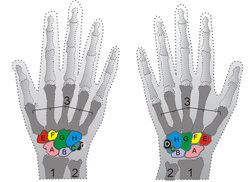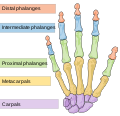Carpal bones
| Carpals | |
|---|---|
 | |
| Details | |
| Identifiers | |
| Latin | ossa carpi |
| MeSH | D002348 |
| TA98 | A02.4.08.001 |
| TA2 | 1249 |
| FMA | 23889 |
| Anatomical terms of bone | |
In tetrapods, the carpals is the sole cluster of the bones in the wrist between the radius and ulna and the metacarpus. The bones of the carpus do not belong to individual fingers (or toes in quadrupeds), whereas those of the metacarpus do. The corresponding part of the foot is the tarsus. Carpal bones are not considered part of the hand but are part of the wrist. The carpal bones allow the wrist to move and rotate vertically, horizontally and laterally.
In crustaceans, "carpus" is the scientific term for the claws or "pincers" present on some legs.
Variations
In some macropods, the scaphoid and lunar bones are fused into the scaphollunar bone.[1]
The carpus
| Row | Name | Proximal/radial articulations | Distal articulations | Metacarpal articulations |
| Proximal | Scaphoid | radius, lunate | trapezium, trapezoid, capitate | - |
| Proximal | Lunate | radius, scaphoid, triquetral | capitate, hamate | - |
| Proximal | Triquetral | lunate, pisiform (but NOT ulna) | hamate | - |
| Proximal | Pisiform (sesamoid bone) | triquetral | - | - |
| Distal | Trapezium | scaphoid | trapezoid | #1 and #2 |
| Distal | Trapezoid | scaphoid | trapezium, capitate | #2 |
| Distal | Capitate | scaphoid, lunate | trapezoid, hamate | #2, #3 and #4 |
| Distal | Hamate | triquetral, lunate | capitate | #4 and #5 |
The mnemonic "She Looks Too Pretty. Try To Catch Her" can be used to remember the carpal bones.[2]
Characteristics
Almost all carpals (except the pisiform) have six surfaces. Of these the palmar or anterior and the dorsal or posterior surfaces are rough, for ligamentous attachment; the dorsal surfaces being the broader, except in the lunate.
The superior or proximal, and inferior or distal surfaces are articular, the superior generally convex, the inferior concave; the medial and lateral surfaces are also articular where they are in contact with contiguous bones, otherwise they are rough and tuberculated.
The structure in all is similar: cancellous tissue enclosed in a layer of compact bone.
See also
Additional images
-
Human hand bones
-
Bones of the left hand. Palmar surface.
-
Bones of the left hand. Dorsal surface.
-
Vertical section through the articulations at the wrist, showing the synovial cavities.
References
- ^ Swamp Wallaby (Wallabia bicolor) carpals
- ^ MnemonicCarpal bones
External links
- Anatomy photo:08:os-0101 at the SUNY Downstate Medical Center - "Palm of the Hand: Carpal bones"
- Hand kinesiology at the University of Kansas Medical Center
- Carpal bones:Mnemonic




